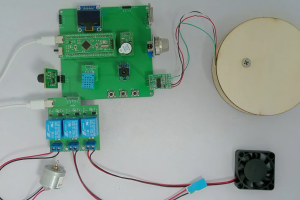设计说明书
总字数:20000+
摘要
随着养宠行业的蓬勃发展,猫咪的健康养护受到越来越多宠物主人的重视,猫砂盆作为猫咪日常生活的重要设施,其清洁管理与环境调控对猫咪的健康至关重要。传统的猫砂盆管理依赖人工检查猫砂余量、手动清洁和通风,不仅耗时费力,还存在猫砂补充不及时、清洁滞后、环境参数失控等问题,难以满足现代化养宠的精细化需求。
基于 STM32F103C8T6 单片机的智能猫砂盆控制系统,整合了 HX711 称重模块、D203S 热释电传感器、MQ-135 氨气传感器、DHT11 温湿度传感器、MLX90614 体温传感器、3 个独立按键、OLED 显示屏、ESP8266 WIFI 模块及执行设备(翻砂电机、消毒灯、通风装置、声光报警装置),实现了猫砂盆的自动化监测与智能管控。系统核心功能包括:通过 HX711 称重模块计算猫砂余量,当余量低于设置最小值(0-200g)时,触发声光报警提醒添加猫砂;借助 D203S 热释电传感器检测猫咪进出状态,猫咪离开后延时 10 秒启动翻砂电机和消毒灯,若检测到猫咪进入则立即停止操作;通过 MQ-135 传感器监测氨气浓度,超过最大值时启动通风并声光报警;利用 DHT11 检测环境温湿度,任一参数超标时开启通风;通过 MLX90614 监测宠物体温;支持通过 3 个独立按键设置各参数阈值,手动控制翻砂、消毒和通风;通过 OLED 显示屏实时显示各项检测数据;借助 ESP8266 WIFI 模块将数据传输至手机端,实现远程设置阈值及控制翻砂、消毒、通风功能。
该系统的实现,有效提升了猫砂盆管理的自动化与智能化水平,减少了人工干预,确保了猫砂盆环境的清洁与安全,为猫咪提供了健康舒适的如厕环境,同时为同类宠物智能设备的研发提供了参考,具有较高的实际应用价值。
关键词:STM32F103C8T6;智能猫砂盆;控制系统;传感器;远程监控;自动调控
ABSTRACT
With the vigorous development of the pet-raising industry, the health care of cats has attracted more and more attention from pet owners. As an important facility in cats’ daily life, the cleaning management and environmental regulation of cat litter boxes are crucial to cats’ health. Traditional cat litter box management relies on manual inspection of litter 余量,manual cleaning and ventilation, which is not only time-consuming and labor-intensive, but also has problems such as untimely litter replenishment, delayed cleaning, and out-of-control environmental parameters, making it difficult to meet the refined needs of modern pet-raising.
The intelligent cat litter box control system based on STM32F103C8T6 microcontroller integrates HX711 weighing module, D203S pyroelectric sensor, MQ-135 ammonia sensor, DHT11 temperature and humidity sensor, MLX90614 pet temperature sensor, 3 independent buttons, OLED display, ESP8266 WIFI module and executive devices (litter turning motor, disinfection lamp, ventilation device, sound and light alarm device), realizing automatic monitoring and intelligent management of the cat litter box. The core functions of the system include: calculating the remaining amount of cat litter through the HX711 weighing module, and when the remaining amount is lower than the set minimum value (0-200g), triggering an audible and visual alarm to remind adding cat litter; detecting the cat’s entry and exit status with the D203S pyroelectric sensor, starting the litter turning motor and disinfection lamp 10 seconds after the cat leaves, and stopping the operation immediately if a cat is detected entering; monitoring the ammonia concentration through the MQ-135 sensor, starting ventilation and giving an audible and visual alarm when it exceeds the maximum value; detecting the environmental temperature and humidity with DHT11, and turning on ventilation when either parameter exceeds the standard; monitoring the pet’s body temperature through MLX90614; supporting the setting of various parameter thresholds through 3 independent buttons, and manual control of litter turning, disinfection and ventilation; real-time display of various detection data through the OLED display; transmitting data to the mobile phone through the ESP8266 WIFI module to realize remote setting of thresholds and control of litter turning, disinfection and ventilation.
The implementation of this system effectively improves the automation and intelligence level of cat litter box management, reduces manual intervention, ensures the cleanliness and safety of the cat litter box environment, provides a healthy and comfortable toilet environment for cats, and also provides a reference for the research and development of similar pet intelligent devices, with high practical application value.
Keywords: STM32F103C8T6; Intelligent cat litter box; Control system; Sensor; Remote monitoring; Automatic regulation
目录
第 1 章 绪论
1.1 研究的目的及意义
1.2 国内外发展情况
1.3 本文主要研究内容
第2章 设计思路与方案论证
2.1 主要元器件选择
2.1.1 主控芯片选择
2.1.2 称重模块选择
2.1.3 人体感应模块选择
2.1.4 气体传感器选择
2.1.5 温湿度传感器选择
2.1.6 体温传感器选择
2.1.7 按键模块选择
2.1.8 显示模块选择
2.1.9 WIFI 模块选择
2.2整体设计方案
第 3 章 硬件设计
3.1 主控电路模块
3.2 称重模块电路
3.3 人体感应模块电路
3.4 气体传感器电路
3.5 温湿度传感器电路
3.6 体温传感器电路
3.7 显示模块电路
3.8 WIFI 模块电路
3.9 按键模块电路
3.10 执行设备驱动电路
第4章 系统程序设计
4.1 编程软件介绍
4.2 系统主流程设计
4.3 OLED显示子流程设计
4.4 独立按键子流程设计
4.5 ADC模数转换子流程设计
4.6 温湿度检测模块子流程设计
4.7 红外测温模块子流程设计
4.8 称重模块子流程设计
4.9 WiFi模块子流程设计
第 5 章 实物测试
5.1 整体实物测试
5.2 称重模块功能测试
5.3 人体感应模块功能测试
5.4 气体传感器功能测试
5.5 温湿度传感器功能测试
5.6 体温传感器功能测试
5.7 WIFI 模块功能测试
5.8 按键设置与显示功能测试
第 6 章 总结与展望
6.1 总结
6.2 展望
致谢
参考文献
附录
附录一:原理图
附录二:PCB
附录三:主程序
购买后可查看具体内容!

